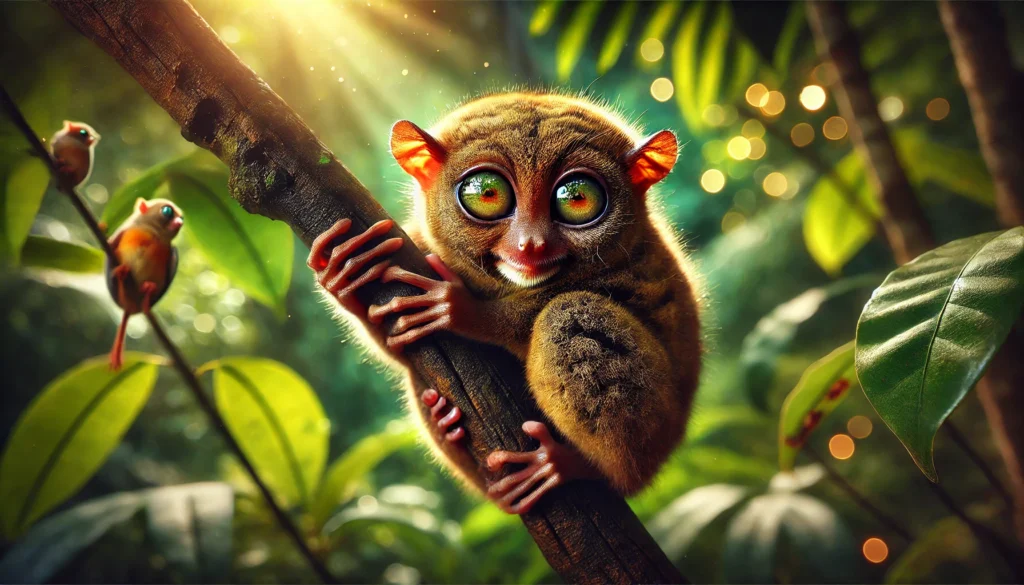Welcome, fellow primate enthusiasts and curious readers! Today, we’re diving into the fascinating world of one of nature’s most adorable and peculiar creatures: the tarsier. Now, I know what you’re thinking – “What in the world is a tarsier?” Well, buckle up, because you’re about to embark on a journey to discover these pint-sized primates that pack a powerful punch in the cuteness department. Imagine a creature with eyes so big they’d make an anime character jealous, ears that could pick up a whisper from a mile away, and fingers so long they’d make any pianist green with envy. That, my friends, is the tarsier in a nutshell. These diminutive daredevils are not only the world’s smallest primates but also some of the most unique and endangered. So, grab a cup of coffee (or a thimble-sized one if you want to drink like a tarsier), and let’s explore the world of these tiny titans!
The Tarsier’s Tale: A Brief History and Evolution
From Ancient Origins to Modern Marvels
Let’s take a trip down memory lane – and by memory lane, I mean way, way back. We’re talking millions of years ago when dinosaurs were still the cool kids on the block. Tarsiers have been around for a mind-boggling 45 million years, making them one of the oldest surviving primate species. That’s right, these little guys have been hanging around since before your great-great-great (add a few more “greats”) grandparents were even a twinkle in evolution’s eye. They’ve seen continents shift, ice ages come and go, and countless species rise and fall. Talk about staying power! But how did these curious creatures come to be? Well, it’s a tale of adaptation, survival, and some seriously impressive night vision.
Evolutionary Marvels: Adapting to the Night Life
Tarsiers didn’t just wake up one day and decide to become nocturnal party animals. Their evolution into night-dwelling acrobats was a gradual process, driven by the need to survive in a world full of predators and competition. Over millions of years, they developed those trademark enormous eyes, which are actually so big that they can’t even move them in their sockets. Instead, tarsiers can rotate their heads a whopping 180 degrees in each direction, giving them an almost owl-like ability to survey their surroundings. And let’s not forget those long, slender fingers and toes, perfect for gripping branches and snagging unsuspecting insects. It’s like Mother Nature decided to create the ultimate night-time ninja, complete with built-in night-vision goggles and grappling hooks!
Tarsier 101: Getting to Know Our Goggle-Eyed Friends
Physical Characteristics: Small Package, Big Surprises
Alright, let’s get down to the nitty-gritty of what makes a tarsier a tarsier. First off, these little guys are tiny – we’re talking “could fit in the palm of your hand” tiny. Most species of tarsiers measure between 3.5 to 6 inches (9-15 cm) in body length, not including their tails. But don’t let their small size fool you; tarsiers are packed with fascinating features that make them stand out in the primate crowd. Let’s break down some of their most notable characteristics:
| Feature | Description | Fun Fact |
|---|---|---|
| Eyes | Enormous, each about the size of their brain | Can’t move their eyes, but can rotate their head 180° each way |
| Hands | Long fingers with pad-like tips for gripping | Middle finger is as long as their entire arm |
| Feet | Elongated ankle bones (tarsus) give them their name | Can leap up to 40 times their body length |
| Tail | Long and usually hairless, used for balance | Some species have a tuft of hair at the end |
| Ears | Large and bat-like, can move independently | Can hear frequencies higher than humans |
Behavior and Lifestyle: Nocturnal Ninjas
Now that we’ve got the looks covered, let’s talk about how these little dudes live their lives. Tarsiers are the ultimate night owls, spending their days catching some Z’s and their nights living it up in the forest canopy. But don’t expect to find them at any wild primate parties – tarsiers are generally solitary creatures, coming together only for mating and occasional family bonding. Here’s a typical day (or should I say night) in the life of a tarsier:
- Wake up as the sun sets, stretching those long limbs and doing a few head rotations to get the blood flowing.
- Spend the evening leaping from tree to tree, covering distances up to 5 meters in a single bound. (Take that, Superman!)
- Hunt for insects, small vertebrates, and the occasional bird or bat. Tarsiers are the only entirely carnivorous primates, so no salads for these meat-lovers.
- Mark their territory with scent glands and vocalizations. Some species can produce ultrasonic calls that would make a dog’s ears perk up.
- If it’s mating season, maybe engage in some tarsier flirting (we’ll leave the details to your imagination).
- As dawn approaches, find a cozy spot to sleep, often clinging vertically to a tree trunk or nestled in a tangle of vines.
Tarsier Species: A Diverse Family of Goggle-Eyed Wonders
Meet the Tarsier Clan
You might think all tarsiers look alike (I mean, those eyes are pretty distracting), but there’s actually quite a bit of diversity in the tarsier family. Scientists recognize several distinct species, each with its own unique characteristics and geographical range. Let’s introduce you to some of the stars of the tarsier world:
- Philippine Tarsier (Carlito syrichta): The poster child of tarsiers, found in the southern Philippines. Known for its especially large eyes and cute factor that’s off the charts.
- Spectral Tarsier (Tarsius spectrum): Native to the Indonesian island of Sulawesi, this species is known for its ghost-like appearance and eerie vocalizations.
- Pygmy Tarsier (Tarsius pumilus): The smallest of the small, rediscovered in 2008 after being thought extinct for 80 years. Talk about a comeback!
- Horsfield’s Tarsier (Cephalopachus bancanus): Found in Borneo and parts of Indonesia, this species is known for its distinctive facial markings.
- Dian’s Tarsier (Tarsius dentatus): Another Sulawesi native, named after the famous primatologist Dian Fossey. (No, she didn’t study tarsiers, but it’s still a cool namesake!)
Geographical Distribution: Where in the World are Tarsiers?
Now that we’ve met some of the tarsier family, you might be wondering where you can go to catch a glimpse of these nocturnal ninjas in their natural habitat. Well, pack your bags for Southeast Asia, because that’s where all the tarsier action is happening! Tarsiers are found exclusively in the islands of Southeast Asia, with different species occupying various islands and regions. Here’s a quick rundown of tarsier hotspots:
- Philippines: Home to the famous Philippine Tarsier, found primarily on the islands of Bohol, Samar, Leyte, and Mindanao.
- Indonesia: The island of Sulawesi is a tarsier paradise, hosting several species including the Spectral and Dian’s Tarsiers.
- Malaysia: Borneo is home to Horsfield’s Tarsier, sharing the island with parts of Indonesia and Brunei.
- Brunei: Also home to populations of Horsfield’s Tarsier.
So, if you’re planning a Southeast Asian adventure and want to add “tarsier spotting” to your itinerary, these are the places to be!
The Tarsier’s Plight: Threats and Conservation Challenges
Human Impact: When Big Feet Stomp on Little Habitats
Alright, time to get a bit serious (but don’t worry, we’ll keep it light-hearted). As adorable and fascinating as tarsiers are, they’re facing some pretty big challenges in their tiny world. And, spoiler alert: humans are the main culprits. Here’s how our big, clumsy human activities are causing problems for our goggle-eyed friends:
- Deforestation: Imagine waking up one day to find your house has been turned into a parking lot. That’s basically what’s happening to tarsiers as their forest homes are cleared for agriculture, logging, and urban development.
- Habitat Fragmentation: Even when forests aren’t completely destroyed, they’re often chopped up into smaller pieces. For tarsiers, this is like trying to navigate a city where all the roads have been turned into canyons.
- Pet Trade: Some people think tarsiers would make cute pets (spoiler: they don’t). Illegal capture for the pet trade is a serious threat to wild populations.
- Tourism: While eco-tourism can be great for conservation, poorly managed wildlife tourism can stress out tarsiers faster than a cat in a room full of rocking chairs.
- Climate Change: As if tarsiers didn’t have enough to worry about, now they have to deal with changing weather patterns and shifting ecosystems. Talk about a global-scale game of musical chairs!
Natural Predators: It’s a Jungle Out There
As if dealing with human-caused threats wasn’t enough, tarsiers also have to keep an eye out (a big eye, in their case) for natural predators. In the wild, these little guys are on the menu for a variety of hungry creatures:
- Owls: The nocturnal nemesis of tarsiers, always on the lookout for a goggle-eyed snack.
- Snakes: Slithering threats that can sneak up on even the most vigilant tarsier.
- Cats: Both wild and domestic felines find tarsiers to be tempting targets.
- Birds of Prey: During twilight hours, eagles and hawks pose a serious threat from above.
It’s a tough world out there for a tiny primate, and these natural predators keep tarsier populations in check. However, with human-caused threats already putting pressure on tarsier numbers, natural predation can become an even more significant challenge for vulnerable populations.
Conservation Efforts: Saving the Goggle-Eyed Wonders
Current Conservation Status: A Mixed Bag of News
Now, I know what you’re thinking: “With all these threats, how are tarsiers doing?” Well, it’s a bit of a mixed bag. Some species are holding their own, while others are teetering on the edge of extinction. Let’s break it down:
| Species | IUCN Red List Status (as of 2020) | Population Trend |
|---|---|---|
| Philippine Tarsier | Near Threatened | Decreasing |
| Spectral Tarsier | Vulnerable | Decreasing |
| Pygmy Tarsier | Data Deficient | Unknown |
| Horsfield’s Tarsier | Vulnerable | Decreasing |
| Dian’s Tarsier | Vulnerable | Decreasing |
As you can see, it’s not all doom and gloom, but it’s not exactly a tarsier party either. The good news is that people are starting to wake up to the plight of these pint-sized primates, and conservation efforts are gaining momentum.
Conservation Initiatives: Giving Tarsiers a Helping Hand
Fear not, tarsier lovers! There are plenty of dedicated folks out there working hard to ensure that future generations will still have the chance to marvel at these goggle-eyed wonders. Here are some of the ways conservationists are fighting the good fight for tarsiers:
- Protected Areas: Establishing and expanding protected areas where tarsiers can live their best nocturnal lives without human interference.
- Habitat Restoration: Planting trees and restoring degraded forests to give tarsiers more room to leap and lounge.
- Research and Monitoring: Studying tarsier populations and behavior to better understand how to protect them. (It’s a tough job, but someone’s got to stay up all night watching tiny primates!)
- Community Education: Teaching local communities about the importance of tarsiers and how to coexist with these pint-sized neighbors.
- Eco-tourism Regulation: Developing guidelines for responsible tarsier tourism that doesn’t stress out our goggle-eyed friends.
- Anti-poaching Efforts: Cracking down on the illegal capture and trade of tarsiers. (Sorry, folks, no tarsier pets allowed!)
- Captive Breeding Programs: As a last resort, some organizations are working on breeding tarsiers in captivity to help boost wild populations.
The Role of Zoos and Sanctuaries: A Double-Edged Sword
The Good, The Bad, and The Goggle-Eyed
Zoos and wildlife sanctuaries play a complicated role in tarsier conservation. On one hand, they can be fantastic educational tools, raising awareness about these unique primates and the challenges they face. On the other hand, tarsiers are notoriously difficult to keep in captivity, and many don’t survive long outside their natural habitat. Let’s break down the pros and cons:
Pros of Zoos and Sanctuaries:
- Raise public awareness about tarsiers and their conservation needs
- Provide opportunities for research and study
- Can serve as a backup plan for critically endangered species
- May contribute to captive breeding programs
Cons of Zoos and Sanctuaries:
- Tarsiers often struggle to thrive in captivity
- May inadvertently promote the idea that tarsiers make good pets
- Can be stressful for these naturally solitary and nocturnal animals
- Limited space and artificial environments can’t fully replicate natural habitats
The bottom line? While zoos and sanctuaries can play a role in tarsier conservation, the best place for these little guys is undoubtedly in their natural forest homes. So, if you’re dying to see a tarsier, consider planning a responsible eco-tour to their native habitats instead of seeking them out in captivity.
What Can You Do? Becoming a Tarsier Champion
Small Actions for Small Primates
Feeling inspired to help our goggle-eyed friends? Good news! You don’t need to be a superhero or a millionaire to make a difference in tarsier conservation. Here are some ways you can become a tarsier champion from the comfort of your own home (or wherever you happen to be reading this):
- Spread the Word: Share the tarsier love! Tell your friends, family, and social media followers about these amazing creatures and the challenges they face.
- Support Conservation Organizations: Donate to reputable organizations working to protect tarsiers and their habitats. Every little bit helps!
- Be a Responsible Tourist: If you’re lucky enough to visit tarsier habitats, choose eco-friendly tours and accommodations that prioritize animal welfare and conservation.
- Reduce Your Carbon Footprint: Climate change affects tarsiers too! Do your part to reduce your environmental impact.
- Say No to Wildlife Souvenirs: Don’t buy products made from endangered species or support the illegal wildlife trade.
- Educate Yourself and Others: Keep learning about tarsiers and other endangered species, and share your knowledge with others.
- Support Sustainable Products: Choose products that don’t contribute to deforestation in tarsier habitats, like sustainable palm oil.
Remember, even small actions can add up to make a big difference for these tiny primates!
A Future for the Goggle-Eyed Wonders
As we wrap up our journey through the fascinating world of tarsiers, let’s take a moment to reflect on these incredible creatures. From their ancient origins to their modern-day struggles, tarsiers have proven themselves to be true survivors. Their unique adaptations, quirky behaviors, and undeniable cuteness make them one of nature’s most captivating creations. But as we’ve seen, the future of these goggle-eyed wonders is far from certain. The challenges they face are significant, but so is the growing movement to protect them. With continued conservation efforts, increased awareness, and the support of tarsier enthusiasts like you, there’s hope that these pint-sized primates will continue to enchant and amaze us for generations to come. So, the next time you find yourself staring wide-eyed at a challenge in your own life, channel your inner tarsier – adapt, persevere, and maybe rotate your head 180 degrees for good measure. After all, if these tiny titans can survive for 45 million years, surely we can handle whatever life throws our way!
Disclaimer: The information in this blog post is accurate to the best of our knowledge as of 2020. However, scientific understanding and conservation statuses can change over time. We encourage readers to consult the most up-to-date sources for current information on tarsier species and their conservation status. If you notice any inaccuracies in this post, please report them so we can correct them promptly. Our goal is to provide accurate and engaging information to support tarsier conservation efforts.




